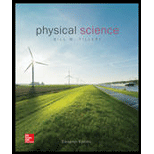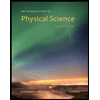
Physical Science
11th Edition
ISBN: 9780077862626
Author: Bill Tillery, Stephanie J. Slater, Timothy F. Slater
Publisher: McGraw-Hill Education
expand_more
expand_more
format_list_bulleted
Concept explainers
Textbook Question
Chapter 17, Problem 3QFT
Explain why each mineral has its own unique set of physical properties.
Expert Solution & Answer
Want to see the full answer?
Check out a sample textbook solution
Students have asked these similar questions
Why are the silicates the most abundant mineral group in the Earth's crust? Explain in no more than 3 sentences.
Chapter 17 Solutions
Physical Science
Ch. 17 - 1. A naturally occurring inorganic solid element...Ch. 17 - 2. A structural unit that is repeated in three...Ch. 17 - 3. Which element is the most abundant in Earth’s...Ch. 17 - 4. Minerals are classified as
a. silicates.
b....Ch. 17 - 5. The most abundant class of nonsilicates is...Ch. 17 - 6. Silicates are classified into two groups based...Ch. 17 - 7. The color of a mineral when it is finely...Ch. 17 - 8. The hardness of a mineral is rated using the
a....Ch. 17 - 9. The ratio of the mineral’s density to the...Ch. 17 -
10. Molten rock material from which minerals...
Ch. 17 -
11. An aggregation of one or more minerals that...Ch. 17 -
12. Rocks that are formed from molten minerals...Ch. 17 -
13. Igneous rock that slowly cooled deep below...Ch. 17 -
14. The rock that makes up the bulk of Earth’s...Ch. 17 -
15. The rock that makes up the ocean basins and...Ch. 17 -
16. Rocks that are formed from particles of other...Ch. 17 - 17. Accumulations of silt, sand, or other...Ch. 17 - 18. Limestone and dolomite are
a. sandstone.
b....Ch. 17 - 19. Heat and pressure change rocks into
a.igneous...Ch. 17 - 20. The relationship between rocks that are...Ch. 17 - 21. The thin layer that covers Earth’s surface is...Ch. 17 - 22. Based on its abundance in Earth's crust, most...Ch. 17 - 23. The most common rock in Earth's crust is
a....Ch. 17 - 24. An intrusive igneous rock will have which type...Ch. 17 - 25. Which igneous rock would have the greatest...Ch. 17 - 26. Which of the following formed from previously...Ch. 17 - 27. Sedimentary rocks are formed by the processes...Ch. 17 - 28. The greatest extent of metamorphic changes has...Ch. 17 - 29. Which type of rock probably existed first,...Ch. 17 - 30. Earth is unique because it has
a. CO2 in its...Ch. 17 - 31. The common structural feature of all silicates...Ch. 17 - 32. The one group that is not a subgroup of the...Ch. 17 - 33. The property that is not considered useful in...Ch. 17 - 34. The specific gravity of a mineral depends on...Ch. 17 - 35. Fluorite is a mineral that floats in liquid...Ch. 17 - 36. The group that is not a class of rocks is
a....Ch. 17 - 37. The classification of rocks is based on
a....Ch. 17 - 38. An example of a sedimentary rock is
a....Ch. 17 - 39. The term that does not describe a size of...Ch. 17 - 40. Dissolved rock materials form
a. chemical...Ch. 17 - 41. An example of a metamorphic rock is
a....Ch. 17 - 42. Extrusive igneous rocks are formed on Earth’s...Ch. 17 - 43. Foliation is found in
a. sedimentary rocks.
b....Ch. 17 - Prob. 1QFTCh. 17 - Prob. 2QFTCh. 17 - 3. Explain why each mineral has its own unique set...Ch. 17 - 4. Identify at least eight physical properties...Ch. 17 - 5. Explain how the identity of an unknown mineral...Ch. 17 - 6. What is a rock?
Ch. 17 - 7. Describe the concept of the rock cycle.
Ch. 17 - Prob. 8QFTCh. 17 - 9. Which major kind of rock, based on the way it...Ch. 17 -
10. What is the difference between magma and...Ch. 17 -
11. What is meant by the “texture" of an igneous...Ch. 17 -
12. What are the basic differences between...Ch. 17 -
13. Explain why a cooled and crystallized magma...Ch. 17 - Prob. 14QFTCh. 17 -
15. What are clastic sediments? How are they...Ch. 17 -
16. Briefly describe the rock-forming process...Ch. 17 - 17. What are metamorphic rocks? What limits the...Ch. 17 - 18. Describe what happens to the minerals as shale...Ch. 17 - Prob. 19QFTCh. 17 - 1. What are the significant similarities and...Ch. 17 - 2. Is ice a mineral? Describe reasons to support...Ch. 17 - 3. If ice is a mineral, is a glacier a rock?...Ch. 17 - Prob. 4FFACh. 17 - 1. A sample of the mineral sylvite measures 2.68...Ch. 17 - 2. A rectangular crystal of calcium plagioclase...Ch. 17 - 3. A spherical specimen of the mineral quartz...Ch. 17 - 4. Geologists separate nonferromagnesian silicates...Ch. 17 - 5. Compare the mineral halite (NaCl, hardness of...Ch. 17 - 6. Mica is a sheet silicate while quartz is a...Ch. 17 - 7. Magnesite is a magnesium ore mineral and has...Ch. 17 - 8. Magnetite and hematite are iron ore minerals....Ch. 17 - 9. An iron mine has an ore deposit estimated at...Ch. 17 - 10. An ore deposit consisting of chert and...Ch. 17 -
11. For a given igneous rock type, the proportion...Ch. 17 -
12. Based on Figure 17.13, what is the average...Ch. 17 -
13. A gabbro countertop measuring 4.70 m long by...Ch. 17 -
14. A sandstone building stone measuring 50.0 cm...Ch. 17 - Prob. 15PEB
Additional Science Textbook Solutions
Find more solutions based on key concepts
Why doesnt Earths rotation provide a suitable time standard?
Essential University Physics (3rd Edition)
A device for training astronauts and jet fighter pilots is designed to rotate the trainee in a horizontal circl...
Physics for Scientists and Engineers with Modern Physics
Choose the best answer to each of the following. Explain your reasoning. If Earth were twice as far as it actua...
The Cosmic Perspective Fundamentals (2nd Edition)
1. Rub your hands together vigorously. What happens? Discuss the energy transfers and transformations that take...
College Physics: A Strategic Approach (4th Edition)
7. (II) (a) What is the current in the element of an electric clothes dryer with a resistance of 8.6 ?when it i...
Physics: Principles with Applications
1.19 [I] An ant walked 10.0 cm across the floor in 6.2 s. What was its average speed in m/s?
[Hint: 2 signi...
Schaum's Outline of College Physics, Twelfth Edition (Schaum's Outlines)
Knowledge Booster
Learn more about
Need a deep-dive on the concept behind this application? Look no further. Learn more about this topic, physics and related others by exploring similar questions and additional content below.Similar questions
- Define the mineralogical terms luster and streak.arrow_forwardWhat are the limits of the Mohs scale? Give an example mineral at each limit.arrow_forwardDensity is related most closely with which property of identifying minerals? (22.1) (a) hardness (b) specific gravity (c) color (d) fracturearrow_forward
- You are given five transparent objects: a calcite crystal, a diamond, a piece of window glass, a sample of quartz, and a piece of zircon. How would you go about identifying each sample? How would they rank on the Mohs hardness scale?arrow_forwardWhat is a mineral, and what is the study of minerals called?arrow_forwardIn lab, your instructor hands you a steel-gray mineral and asks you to identify it. You find that the mineral gives a red-brown streak. What is the minerals probable identity?arrow_forward
arrow_back_ios
arrow_forward_ios
Recommended textbooks for you
 An Introduction to Physical SciencePhysicsISBN:9781305079137Author:James Shipman, Jerry D. Wilson, Charles A. Higgins, Omar TorresPublisher:Cengage Learning
An Introduction to Physical SciencePhysicsISBN:9781305079137Author:James Shipman, Jerry D. Wilson, Charles A. Higgins, Omar TorresPublisher:Cengage Learning

An Introduction to Physical Science
Physics
ISBN:9781305079137
Author:James Shipman, Jerry D. Wilson, Charles A. Higgins, Omar Torres
Publisher:Cengage Learning
General Relativity: The Curvature of Spacetime; Author: Professor Dave Explains;https://www.youtube.com/watch?v=R7V3koyL7Mc;License: Standard YouTube License, CC-BY